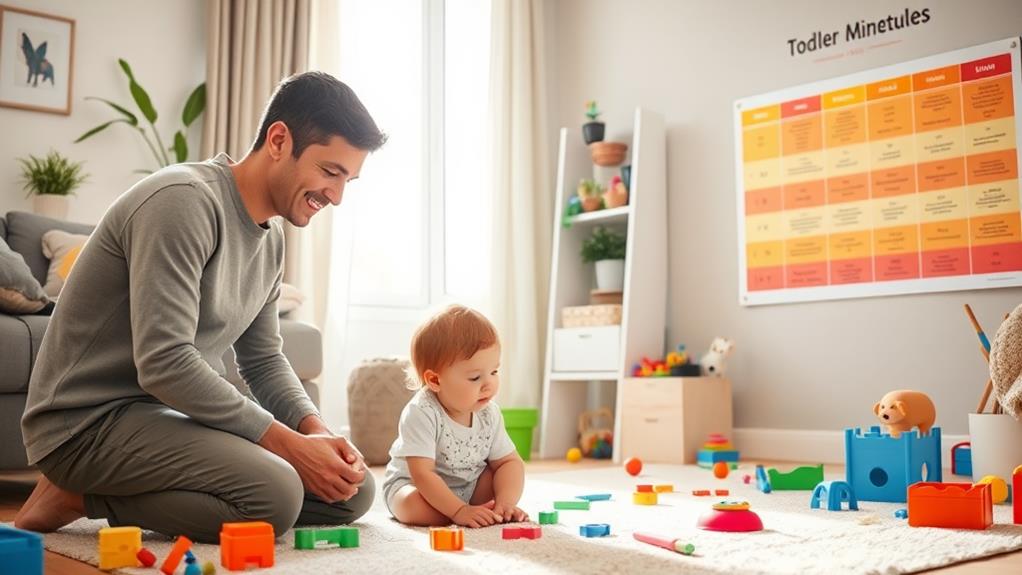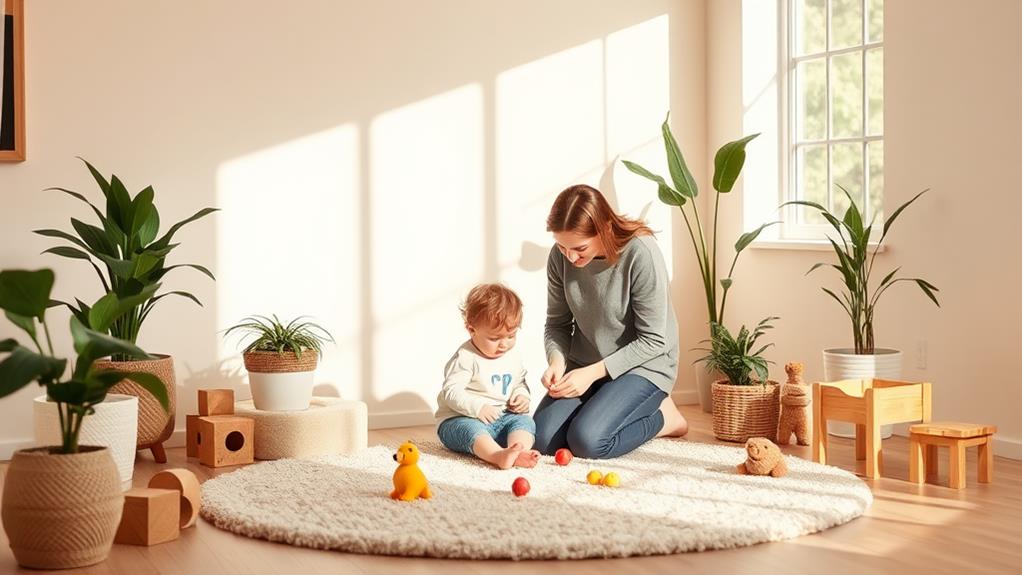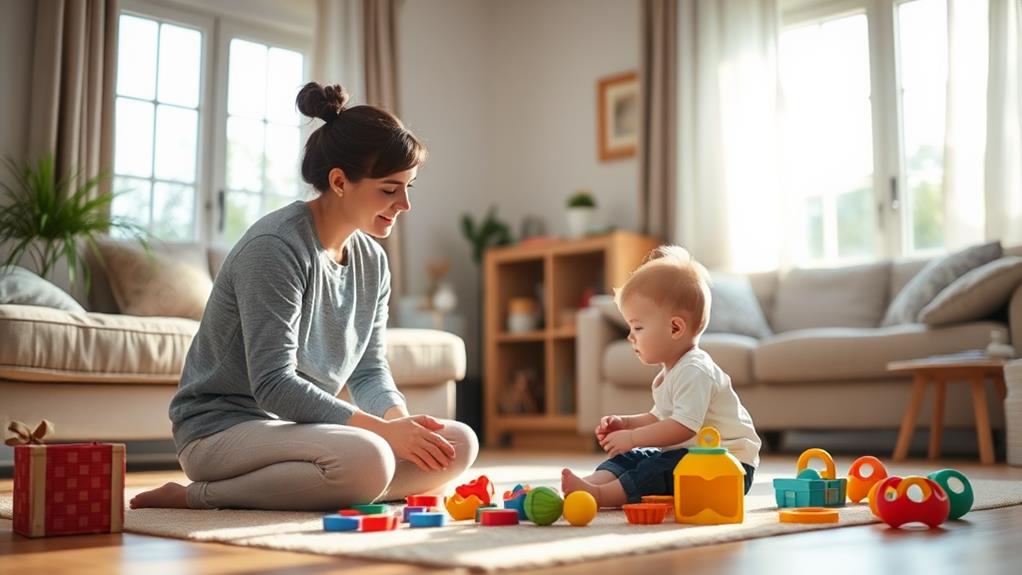Getting your toddler to listen without raising your voice can feel like an uphill battle, but it doesn't have to be. By understanding their developmental stage and setting clear expectations, you can foster a more cooperative environment. Engaging with them on their level and modeling good communication habits can create a foundation for better listening. You might be surprised at how effective small changes can be. What if you could transform those daily struggles into moments of connection? Let's explore some practical strategies that may just change the way you interact with your child.
Understand Toddler Development

Understanding toddler development is crucial for effective communication with your little one. At this stage, toddlers are exploring their world, testing boundaries, and developing their sense of independence. You might notice their emotions can swing from joy to frustration in the blink of an eye. This is completely normal!
Your toddler's brain is rapidly growing, and they're starting to understand language but often can't express themselves fully. You'll find that they might respond better to simple, clear instructions rather than complex sentences. Keep your language straightforward and your tone positive.
Remember, toddlers thrive on routine, so consistency in your communication helps them feel secure. When you engage them, try to get down to their level, both physically and emotionally. This approach not only grabs their attention but also shows them that you're interested in what they've to say.
Lastly, patience is key. They mightn't always understand or listen right away, but with your guidance and support, they'll learn over time. By understanding their development, you'll create a stronger bond and enhance your ability to communicate effectively with your toddler.
Establish Clear Expectations
To help your toddler listen better, establishing clear expectations is vital. When you set clear guidelines, your child knows exactly what behavior you expect from them. Start by communicating these expectations simply and directly. Use short phrases, like "We use our indoor voices" or "Toys stay in the playroom." This clarity makes it easier for them to understand what's acceptable and what isn't.
Be consistent with your expectations. Repeating the same phrases helps reinforce the message, making it stick in your toddler's mind. It's also helpful to explain why these rules matter. For example, you could say, "We use our indoor voices so everyone can hear the story." This gives context, helping your child grasp the importance of listening.
Don't hesitate to model the behavior you want to see. Show enthusiasm when your toddler follows the rules, as this encourages them to continue listening.
Use Positive Reinforcement

Using positive reinforcement can make a big difference in how your toddler listens and responds to instructions. When you catch them doing something right, like picking up their toys or following a direction, praise them immediately. This acknowledgment shows that you notice their efforts and encourages them to repeat the behavior.
Try using specific compliments instead of general ones. For example, say, "I love how you put your shoes away!" rather than just "Good job!" This clarity helps your toddler understand exactly what they did well.
You can also offer small rewards, like stickers or extra playtime, to reinforce good behavior.
Make it a fun game! Turning tasks into a playful experience can motivate your toddler to listen better. Celebrate their successes, no matter how small, to build their confidence and willingness to follow instructions.
Model Active Listening
By demonstrating active listening yourself, you set a powerful example for your toddler. When you engage fully with what your child is saying, you show them that their thoughts and feelings are important. This not only helps build their confidence but also encourages them to listen to you in return.
To model active listening, make eye contact and give your full attention when your toddler speaks. Nod or respond with short phrases like "I see" or "Tell me more" to show you're engaged. By doing this, you're teaching them to recognize the importance of listening to others.
When your toddler feels heard, they're more likely to reciprocate that behavior. Be mindful of your tone and body language; a warm smile and open posture can make a big difference.
If your child struggles to express themselves, help them find the right words. This not only validates their feelings but also enhances their communication skills.
Create a Calm Environment

Creating a calm environment can significantly enhance your toddler's ability to listen. When your surroundings are peaceful, it's easier for your little one to focus on what you're saying. Start by reducing noise levels; turn off the TV or put away distracting toys. Soft background music can create a soothing atmosphere, but keep it gentle and low.
Next, consider the space where you're communicating. A cozy area with comfortable seating can make your toddler feel safe and secure. You might also want to declutter the environment since too many toys or objects can overwhelm them. A clear space helps them concentrate better on your words.
Additionally, pay attention to your own energy. If you're anxious or stressed, your child will likely pick up on those feelings. Take a deep breath and approach conversations with a calm demeanor. Use soft tones and gentle gestures to reinforce this serenity.
Lastly, establish routines. Predictability helps toddlers feel secure, making them more receptive to listening.
Use Visual Aids
Visual aids can transform how your toddler processes information and responds to your instructions. By incorporating pictures, charts, or even colorful schedules, you create a visual reference that makes it easier for them to understand what you're asking. For example, if it's time to clean up, show them a simple image of toys in a box. This not only clarifies your request but also engages their interest.
You can also use visual aids for daily routines. Consider creating a visual schedule that outlines activities like playtime, snack time, and bedtime. When your toddler sees these images, they'll know what to expect, making transitions smoother. It's like giving them a map for the day!
Another effective tool is using labels. Labeling objects around the house can help your toddler associate words with their respective items, reinforcing language development. For instance, stick a label on their toy bin that says "toys."
Lastly, remember to keep the visuals bright and fun! This approach not only captures their attention but also turns learning into a playful experience.
Practice Patience and Consistency

Practicing patience and consistency is crucial when trying to get your toddler to listen. Toddlers are still learning how to communicate and understand the world around them. When you respond with patience, you create a safe space for them to express themselves. It's important to stay calm, even when they test your limits. Remember, they're learning how to navigate their emotions too!
Consistency plays a key role, as it helps your toddler understand what's expected of them. When you set clear boundaries and follow through with them every time, your child will learn to trust your words. For instance, if you ask them to clean up their toys, do this regularly, and always acknowledge their efforts.
Try to create a routine that reinforces listening, like using the same phrases or signals each time. This predictability helps your toddler know what to expect.
Lastly, don't forget that you're both on this journey together. Celebrate small victories along the way, and keep in mind that building these habits takes time. With patience and consistency, you'll notice positive changes in your toddler's listening skills.
